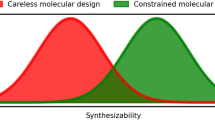Summary
Pharmacophore methods provide a way of establishing a structure--activity relationship for a series of known active ligands. Often, there are several plausible hypotheses that could explain the same set of ligands and, in such cases, it is important that the chemist is presented with alternatives that can be tested with different synthetic compounds. Existing pharmacophore methods involve either generating an ensemble of conformers and considering each conformer of each ligand in turn or exploring conformational space on-the-fly. The ensemble methods tend to produce a large number of hypotheses and require considerable effort to analyse the results, whereas methods that vary conformation on-the-fly typically generate a single solution that represents one possible hypothesis, even though several might exist. We describe a new method for generating multiple pharmacophore hypotheses with full conformational flexibility being explored on-the-fly. The method is based on multiobjective evolutionary algorithm techniques and is designed to search for an ensemble of diverse yet plausible overlays which can then be presented to the chemist for further investigation.
Similar content being viewed by others
References
C. Lemmen T. Lengauer (2000) J. Comput.-Aided Mol. Des. 14 215
Güner, O.F. (Ed.) Pharmacophore Perception, Development, and Use in Drug Design. International University Line, La Jolla, CA, 2000.
O. Dror A. Shulman-Peleg R. Nussinov H. Wolfson (2004) J. Curr. Med. Chem., 11 71
J.H. van Drie (2003) Curr. Pharmaceut. Des., 9 1649
D. Barnum J. Greene A. Smellie P. Sprague (1996) J. Chem. Inf. Comput. Sci., 36 563
A. Smellie S.L. Teig P. Towbin (1995) J. Comp. Chem., 16 171
Y.C. Martin M.G. Bures E.A. Danaher J. DeLazzer I. Lico P.A. Pavlik (1993) J. Comput.-Aided Mol. Des., 7 83
Y. Patel V.J. Gillet G. Bravi A.R. Leach (2002) J. Comput.-Aided Mol. Des., 16 653
G. Jones P. Willett R.C. Glen (1995) J. Comput.-Aided Mol. Des., 9 532
C.M. Fonseca P.J. Fleming (1998) IEEE Trans. Syst. Man Cybernet. Part a–Syst. Humans, 28 26
S. Handschuh M. Wagener J. Gasteiger (1998) J. Chem. Inf. Comput. Sci., 38 220
T. Wright V.J. Gillet D.V.S. Green S.D. Pickett (2003) J. Chem. Inf. Comput. Sci., 43 381
V.J. Gillet W. Khatib P. Willett P.J. Fleming D.V.S. Green (2002) J. Chem. Inf. Comput. Sci., 42 375
O. Nicolotti V.J. Gillet P.J. Fleming D.V.S. Green (2002) J. Med. Chem., 45 5069
N. Brown B. McKay F. Gilardoni J. Gasteiger (2004) J. Chem. Inf. Comput. Sci., 44 1079
Goldberg, D.E. and Richardson J., In Grefenstette, J.J. (Ed.), Genetic Algorithms with Sharing for Multimodal Function Optimisation, Proceedings of the Second International Conference on Genetic Algorithms. Lawrence Erlbaum Associates, Hillsdale, 1987, pp. 41–49.
R.C. Glen A.P. Hill G.R. Martin A.D. Robertson (1995) J. Med. Chem., 38 3566
Z. Wawrzak S. Tatyana J.J. Steffens G.S. Basarab T. Lundqvist Y. Lindqvist D.B. Jordon (1999) Proteins: Struct. Funct. Genet., 35 425
Höberg, T. and Norinder, U., In Krogsgaard-Larsen, P., Liljefors, T. and Madsen, U. (Eds.), A Textbook of Drug Design and Development, 2nd edn., Harwood Academic Publishers, Amsterdam, 1996, pp. 94–130.
T. Liljefors K.P. Bøgesø (1988) J. Med. Chem., 31 306
I. Pettersson T. Liljefors (1992) J. Med. Chem., 35 2355
J. Boström K. Gundertofte T. Liljefors (2000) J. Comput.-Aided Mol. Des., 14 769
Kristam, R., Gillet, V.J., Lewis, R.A. and Thorner, D., J. Chem. Inf. Model., in press.
Author information
Authors and Affiliations
Corresponding author
Rights and permissions
About this article
Cite this article
Cottrell, S.J., Gillet, V.J., Taylor, R. et al. Generation of multiple pharmacophore hypotheses using multiobjective optimisation techniques. J Comput Aided Mol Des 18, 665–682 (2004). https://doi.org/10.1007/s10822-004-5523-7
Received:
Accepted:
Published:
Issue Date:
DOI: https://doi.org/10.1007/s10822-004-5523-7




